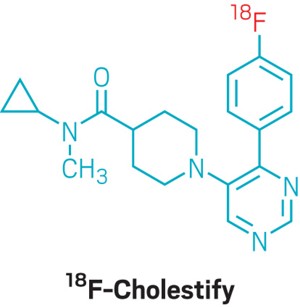Welcome to DU!
The truly grassroots left-of-center political community where regular people, not algorithms, drive the discussions and set the standards.
Join the community:
Create a free account
Support DU (and get rid of ads!):
Become a Star Member
Latest Breaking News
Editorials & Other Articles
General Discussion
The DU Lounge
All Forums
Issue Forums
Culture Forums
Alliance Forums
Region Forums
Support Forums
Help & Search
Science
Related: About this forumRadiochemical reveals cholesterol metabolism in the brain to understand neurodegenerative diseases.
I came across this article in Chemical and Engineering News: Radiochemical reveals cholesterol metabolism in the brain
Subtitle:
New tracer could help drugmakers track how well their candidates for neurodegenerative diseases engage cholesterol-metabolizing enzyme
I'm pretty sure this short news item is only available to ACS members, but it's brief, and here's the relevant excerpt:
Anew radiolabeled molecule could help scientists track the fate of drug candidates for neurodegenerative illnesses like Alzheimer’s disease and Huntington’s disease using positron emission tomography (PET). The PET tracer, called 18F-cholestify, reveals expression of cytochrome P450 46A1 (CYP46A1), a cholesterol-degrading enzyme in the brain (Sci. Trans. Med. 2022, DOI: 10.1126/scitranslmed.adc9967).
CYP46A1 oxidizes cholesterol in the brain, making a cholesterol derivative that can go through the blood-brain barrier so that it can be transported out of the central nervous system. Scientists have suspected that neurodegenerative diseases can be linked to CYP46A1 gone awry, but they haven’t had a way to study the enzyme in living brains.
Seeking a way to do just that, a team led by Emory University’s Steven H. Liang developed 18F-Cholestify to bind to CYP46A1. In PET scans in mice, nonhuman primates, and people, the tracer illuminates areas of the brain where CYP46A1 is expressed. The chemical probe “can give us real-time information,” Liang says. 18F-Cholestify can also help drugmakers test how well drug candidates engage CYP46A1 in the brain, he adds.
Comparing the enzyme’s expression in brains of healthy people with its expression in the brains of people with neurodegenerative diseases could reveal CYP46A1’s role in those conditions. Observing how CYP46A1 is expressed in the brains of people of different ages could also shed light on how the enzyme changes as people age.
Liang’s team found 18F-Cholestify showed a stronger signal in mice engineered to have Alzheimer’s disease compared with control mice. In a study of eight healthy people, 18F-Cholestify revealed that women had a greater expression of CYP46A1 than men of the same age...
CYP46A1 oxidizes cholesterol in the brain, making a cholesterol derivative that can go through the blood-brain barrier so that it can be transported out of the central nervous system. Scientists have suspected that neurodegenerative diseases can be linked to CYP46A1 gone awry, but they haven’t had a way to study the enzyme in living brains.
Seeking a way to do just that, a team led by Emory University’s Steven H. Liang developed 18F-Cholestify to bind to CYP46A1. In PET scans in mice, nonhuman primates, and people, the tracer illuminates areas of the brain where CYP46A1 is expressed. The chemical probe “can give us real-time information,” Liang says. 18F-Cholestify can also help drugmakers test how well drug candidates engage CYP46A1 in the brain, he adds.
Comparing the enzyme’s expression in brains of healthy people with its expression in the brains of people with neurodegenerative diseases could reveal CYP46A1’s role in those conditions. Observing how CYP46A1 is expressed in the brains of people of different ages could also shed light on how the enzyme changes as people age.
Liang’s team found 18F-Cholestify showed a stronger signal in mice engineered to have Alzheimer’s disease compared with control mice. In a study of eight healthy people, 18F-Cholestify revealed that women had a greater expression of CYP46A1 than men of the same age...
Here's the structure of the molecule:

The full paper to which the article refers is here: Haider, Ahmed, Zhao, Chunyu, Wang, Lu, Xiao, Zhiwei, Rong, Jian, Xia, Xiaotian, Chen, Zhen, Pfister, Stefanie K., Mast, Natalia, Yutuc, Eylan, Chen, Jiahui, Li, Yinlong, Shao, Tuo, Warnock, Geoffrey I., Dawoud, Alyaa, Connors, Theresa R., Oakley, Derek H., Wei, Huiyi, Wang, Jinghao, Zheng, Zhihua, Xu, Hao, Davenport, April T., Daunais, James B., Van, Richard S., Shao, Yihan, Wang, Yuqin, Zhang, Ming-Rong, Gebhard, Catherine, Pikuleva, Irina, Levey, Allan I., Griffiths, William J., Liang, Steven H Assessment of cholesterol homeostasis in the living human brain 2022 Science Translational Medicine 14 665 eadc9967
It's behind a firewall though and regrettably I won't have time to discuss it at any length, but I've downloaded it.
Here however, is a nice open sourced overview of 18F radiopharmaceuticals and diagnostic agents: Fluorine-18 Radiochemistry, Labeling Strategies and Synthetic Routes, Orit Jacobson, Dale O. Kiesewetter, and Xiaoyuan Chen Bioconjugate Chemistry 2015 26 (1), 1-18.
It has a nice description of how 18F, which as a 109.8 minute half-life, is synthesized from oxygen's heaviest stable isotope, 18O, for the benefit of anyone who may wish to know.
I trust you had a pleasant weekend. I know I did, contemplating that we kept the Senate and still have hopes for keeping the House.
InfoView thread info, including edit history
TrashPut this thread in your Trash Can (My DU » Trash Can)
BookmarkAdd this thread to your Bookmarks (My DU » Bookmarks)
2 replies, 1251 views
ShareGet links to this post and/or share on social media
AlertAlert this post for a rule violation
PowersThere are no powers you can use on this post
EditCannot edit other people's posts
ReplyReply to this post
EditCannot edit other people's posts
Rec (7)
ReplyReply to this post
2 replies
 = new reply since forum marked as read
Highlight:
NoneDon't highlight anything
5 newestHighlight 5 most recent replies
= new reply since forum marked as read
Highlight:
NoneDon't highlight anything
5 newestHighlight 5 most recent replies
Radiochemical reveals cholesterol metabolism in the brain to understand neurodegenerative diseases. (Original Post)
NNadir
Nov 2022
OP
Goonch
(3,811 posts)1. 18F-Cholestify

eppur_se_muova
(37,403 posts)2. Very neat. Thanks for the link to the review article. nt